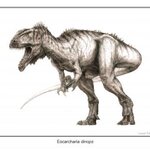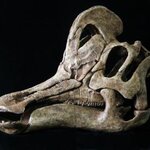Paleontology

Some 270 million plus years ago, had one wanted to buy waterfront property in what is now British Columbia, you’d be looking somewhere between Prince George and the Alberta border. The rest of the province had yet to arrive but would be made up of over twenty major terranes from around the Pacific.
The rock that would eventually become the Cariboo Mountains and form the lakes and valleys of Bowron was far out in the Pacific Ocean, down near the equator. With tectonic shifting, these rocks drifted north-eastward, riding their continental plate, until they collided with and joined the…

Eu que pensava que fontes osteológicas eram apenas os museus ou as jazidas por onde andei!Afinal também existem outras fontes osteológicas...
Imagens - Björn Johansson

Two new 110 million-year-old dinosaurs unearthed in the Sahara Desert highlight the unusual meat-eaters that prowled southern continents during the Cretaceous Period. Named Kryptops and Eocarcharia in a paper appearing this month in the scientific journal Acta Palaeontologica Polonica, the fossils were discovered in 2000 on an expedition led by University of Chicago paleontologist Paul Sereno.
Sereno and co-author paleontologist Stephen Brusatte of the University of Bristol say the new fossils provide a glimpse of an earlier stage in the evolution of the bizarre meat-eaters of Gondwana, the…

Insects will feast and leafy plants will suffer if temperatures warm and atmospheric carbon dioxide increases, according to a team of researchers who studied evidence of insect feeding on fossil leaves from before, during and after the Paleocene-Eocene Thermal Maximum.
The PETM occurred 55.8 million years ago and was an abrupt global warming event linked to a temporary increase in carbon dioxide in the atmosphere. This event is comparable in size and rate to the current climate changes brought on by human activity.
"Our study suggests that increased insect herbivory is likely to be a net,…

Nancy Simmons, do American Museum of Natural History, e restante equipa que publicou a descoberta na revista Nature, avançam que a nova espécie de morcego- Onychonycteris finneyi - ainda não possuiria a capacidade de eco-localização, ou seja, o típico "radar" dos morcegos.
Esta conclusão provém da ausência, no Onychonycteris finneyi, de estruturas osteológicas (ósseas), no ouvido interno, necessários à eco-localização. As proporções e anatomia dos membros anteriores permitem inferir uma capacidade de voo semelhante aos actuais morcegos.
Esta descoberta vem apoiar a hipótese que o voo em…

A new species of dinosaur unearthed in Mexico is giving scientists fresh insights into the ancient history of western North America, according to an international research team led by scientists from the Utah Museum of Natural History at the University of Utah.
“To date, the dinosaur record from Mexico has been sparse,” said Terry Gates, a paleontologist with the Utah Museum of Natural History, Utah’s designated natural history museum.
The new creature — aptly dubbed Velafrons coahuilensis — was a massive plant-eater belonging to a group of duck-billed dinosaurs, or hadrosaurs. “Velafrons is…

Com uma envergadura dos membros anteriores de 25 cm (contra os quase 10 metros do Quetzalcoatlus), o novo pterossáurio chinês é um extremo, na sua pequenez, da variedade de formas de répteis gigantes do mesozóico.
O Nemicolopterus crypticus é uma nova espécie de pterossáurio cujas dimensões o colocam na galeria dos mais invulgares. Foi descoberto na famosa jazida de Liaoning, no nordeste da China, em rochas com 120 milhões de anos.Apesar de juvenil, confirmado pela não fusão de alguns dos seus ossos, estava desprovido de dentes e, inferiram os paleontólogos chineses e brasileiros que o…

The celebrated Bristol Dinosaur, Thecodontosaurus, has been shown to live on subtropical islands around Bristol, instead of in a desert on the mainland as previously thought.
This new research could explain the dinosaur’s small size (2 m) in relation to its giant (10 m) mainland equivalent, Plateosaurus. Like many species trapped on small islands, such as the ‘hobbit’, Homo floresiensis, of Flores and pygmy elephants on Malta, the Bristol Dinosaur may have been subjected to island dwarfing.
Geological mapping indicates that the islands were quite small in size and, judging by abundant…
Scientists from the University of Bonn are researching which plants giant dinosaurs could have lived off more than 100 million years ago in order to find out how they were able to become as large as they did. Such gigantic animals should not have existed.
Their recipe; take 200 milligrams of dried and ground equisetum, ten milliliters of digestive juice from sheep's rumen, a few minerals, carbonate and water. Fill a big glass syringe with the mix, clamp this into a revolving drum and put the whole thing into an incubator, where the brew can rotate slowly.
In this way they obtained an…

Paleontologists, who use estimates based on the fossil record, and scientists who use "molecular clock" methods to study evolutionary history, have never agreed on when modern birds came into existence, because they have had conflicting results.
A new analysis by researchers at the University of Michigan, the University of Chicago, the Centre for Biodiversity Conservation Mexico and Central America, and Boston University offers the strongest molecular evidence yet for an ancient origin of modern birds, suggesting that they arose more than 100 million years ago, not 60 million years ago, as…